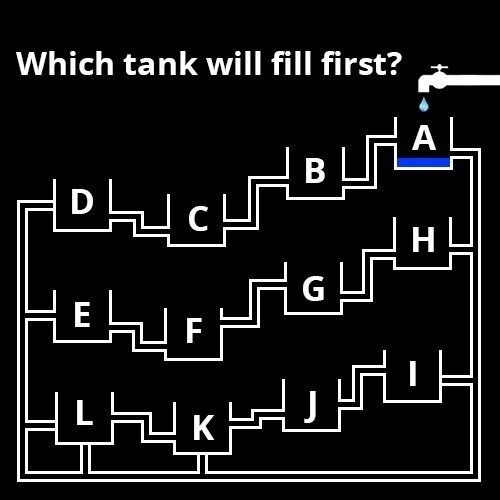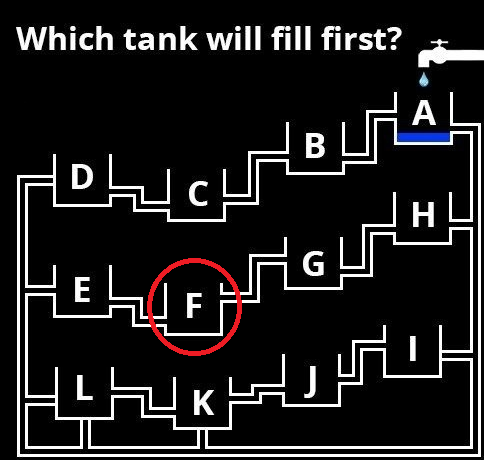Logic puzzles are designed to test your problem-solving skills, and this one is no exception. At first glance, it seems like a simple riddle: just figure out which tank fills first. However, the tricky setup and cleverly placed obstacles make it one of those brain teasers that’s easy to get wrong.
Ready to test your logical thinking? Let’s break down this puzzling situation and find out why Tank F is the correct answer.

The Challenge: Which Tank Will Fill First?
The setup is pretty straightforward. You have a series of interconnected water tanks labeled A, B, C, D, E, F, G, H, I, J, K, L. Water starts flowing from Tank A, and your task is to figure out which tank will be the first to fill up completely.
At first glance, it may seem like any of the lower tanks will fill first. You might think that water simply flows to the nearest or lowest tank. But as with many puzzles, the obvious answer isn’t always the correct one.
Why This Puzzle Is So Deceptive
This brain teaser is designed to play on your assumptions. Most people naturally think that water will flow freely through every pipe, but that’s not the case. The critical detail lies in blocked pathways that prevent water from flowing to certain tanks. You must carefully examine which pipes are open and which are closed to determine the correct path.
Step 1: Analyzing the Flow from Tank A
The water starts flowing from Tank A and moves downward. The first potential path is to the right of Tank A.
However, here’s the trick:
- The pathways leading to Tanks L, K, and I are blocked.
- Since these paths are closed off, the water will not flow in that direction.
Instead, the water rises to the next open path. This is the crucial step that determines the entire outcome.
Step 2: Understanding the Critical Path to Tank F

Since the lower paths are blocked, the water level will rise higher in Tank A. Once it reaches the next open pathway, it flows directly into Tank 2, which eventually leads to Tank F.
Here’s why Tank F fills first:
- Tank F is positioned lower than the other potential tanks in that branch.
- Water always flows to the lowest available point.
- Since Tank F is the first tank in the path without blockages, it will be the first to fill up.
Step 3: Why Not the Other Tanks?
Many people get this puzzle wrong because they don’t notice the blocked pipes. It’s easy to assume that water will simply move downward without any hindrance.
- Tanks L, K, and I are out of the equation because the pathways leading to them are blocked.
- Tanks G, H, and J are also not viable because the water can’t reach them until Tank F fills up completely.
Why Do People Keep Getting It Wrong?
This puzzle is deceptive because it seems so straightforward at first. The brain naturally thinks of water flowing freely, without considering obstacles. Most errors come from these common mistakes:
- Overlooking Blocked Paths: Failing to spot the closed pipes that prevent water flow.
- Assuming the Nearest Tank Fills First: Not accounting for the vertical rise before the water moves to the next tank.
- Rushing the Answer: Jumping to conclusions without carefully tracing the entire path.
Why Tank F Fills First: The Science Behind It
Water naturally follows gravity, moving to the lowest available point. However, gravity isn’t the only factor here—the pathway structure matters just as much.
- Since the lower pipes are blocked, the water is forced to rise in Tank A.
- Once it reaches the next open pathway, it moves horizontally towards Tank 2 and then directly into Tank F.
- Because Tank F is the lowest unblocked tank, it will inevitably fill up first.

How to Approach Puzzles Like This
If you enjoy challenging brain teasers like this one, here are some tips to improve your problem-solving skills:
- Visualize the Flow: Instead of rushing, imagine how the water would move through each pipe.
- Check for Blockages: Always identify any obstacles that could alter the expected path.
- Think Logically, Not Emotionally: Don’t let your instincts guide you without double-checking.
- Analyze the Setup Carefully: Sometimes, small details make a big difference.
Why We Love Puzzles Like This
There’s something incredibly satisfying about solving a tricky problem. It challenges the brain, makes you think differently, and gives a sense of accomplishment when you finally get it right. This tank puzzle is a perfect example of how our brains can be tricked into making assumptions, only to realize that careful analysis was needed all along.
Final Thoughts: A Lesson in Critical Thinking
This puzzle teaches a valuable lesson: always question your assumptions and look for hidden details. Sometimes, the most obvious answer is the wrong one because we tend to overlook small but crucial aspects.
The next time you face a problem that seems too easy, remember this tank puzzle. Take a moment to think critically, examine all possible outcomes, and don’t rush to conclusions. You might just find that the real answer is hiding in plain sight, waiting for you to discover it.


